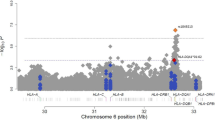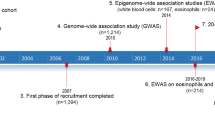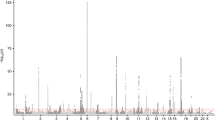Abstract
Asthma is a complex inherited disease. The study was undertaken to identify the association of RANTES promoter polymorphisms with atopy and asthma using family-based association tests (FBATs) and generation-specific case–control analyses. We identified 154 nuclear families (453 individuals) in whom we established RANTES promoter status using the RFLP-PCR method. Of the two known promoter polymorphisms −403G/A and −28C/G, only the former appeared with a clinically relevant frequency. A total of 61 families were eligible for assessment of transmission of the allele with asthma and atopy by the pedigree disequilibrium test (PDT). Overall, allele frequency for −403A was 38.3% and 84 of 89 (94.3%) alleles were transmitted with physician diagnosed asthma (PDA) (P=0.001). All 89 children with atopy received the mutant allele, which was more than expected following Mendelian Laws of transmission (P=0.0001). In 303 unrelated parents, significant associations of the mutant allele were for atopy with or without asthma (P=0.001). In 150 unrelated children, significant associations were for atopy alone (P=0.001) and asthma (P=0.001). No associations were found for bronchial hyper-responsiveness (BHR). The −403 G → A is transmitted with atopy and atopic asthma, although its contribution appears to relate more to atopy than asthma and BHR.
This is a preview of subscription content, access via your institution
Access options
Subscribe to this journal
Receive 6 digital issues and online access to articles
$119.00 per year
only $19.83 per issue
Buy this article
- Purchase on Springer Link
- Instant access to full article PDF
Prices may be subject to local taxes which are calculated during checkout
Similar content being viewed by others
References
Milos F, Snezana C . The role of eosinophils in asthma. Med Biol 2001; 8: 6–10.
Cantani A, Herrera RJ, Cameron C . Respiratory symptoms and lung function in relation to atopy in children. J Allergy Clin Immunol 1999; 6: 305–309.
Settipane RJ, Calvani M, Alessandri C et al. Asthma in childhood. Eur J Immunogenet 1994; 6: 124–131.
Teran LM, Noso N, Carroll M, Davies DE, Holgate S, Schroder JM . Eosinophil recruitment following allergen challenge is associated with the release of the chemokine RANTES into asthmatic airways. J Immunol 1996; 157: 1806–1812.
Conti P, Barbacane RC, Reale M . Chemokines in inflammatory states. Allergy Asthma Proc 1999; 20: 205–208.
Chihara J, Yasuba H, Tsuda A et al. Elevation of the plasma level of RANTES during asthma attacks. J Allergy Clin Immunol 1997; 100: S52–S55.
Schuh JM, Blease K, Hogaboam CM . The role of CC chemokine receptor 5 (CCR5) and RANTES/CCL5 during chronic fungal asthma in mice. FASEB J 2002; 16: 228–230.
Cocchi F, DeVico AL, Garzino-Demo A, Arya SK, Gallo RC, Lusso P . Identification of RANTES, MIP-1-alpha, and MIP-1-beta as the major HIV suppressive factors produced by CD8(+) T cells. Science 1995; 270: 1811–1815.
Cookson WO . A new gene for asthma: would you ADAM and Eve it? Trends Genet 2003; 19: 169–172.
Makki RF, al Sharif F, Gonzalez-Gay MA, Garcia-Porrua C, Ollier WE, Hajeer AH . RANTES gene polymorphism in polymyalgia rheumatica, giant cell arteritis and rheumatoid arthritis. Clin Exp Rheumatol 2000; 18: 391–393.
Liu H, Chao D, Nakayama EE et al. Polymorphism in RANTES chemokine promoter affects HIV-1 disease progression. Proc Natl Acad Sci USA 1999; 96: 4581–4585.
Hizawa N, Yamaguchi E, Konno S, Tanino Y, Jinushi E, Nishimura M . A functional polymorphism in the RANTES gene promoter is associated with the development of late-onset asthma. Am J Resp Crit Care Med 2002; 166: 686–690.
al Sharif F, Ollier WE, Hajeer AH . A rare polymorphism at position −28 in the human RANTES promoter. Eur J Immunogenet 1999; 26: 373–374.
Hajeer AH, al Sharif F, Ollier WE . A polymorphism at position—403 in the human RANTES promoter. Eur J Immunogenet 1999; 26: 375–376.
Weiss MJ, Orkin SH . GATA-transcription factors: key regulators of hematopoiesis. Exp Hematol 1995; 23: 99–107.
Fryer AA, Spiteri MA, Bianco A et al. The −403G → A promoter polymorphism in the RANTES gene is associated with atopy and asthma. Genes Immun 2000; 1: 509–514.
Yao TC, Kuo ML, See LC et al. The RANTES promoter polymorphism: a genetic risk factor for near-fatal asthma in Chinese children. J Allergy Clin Immunol 2003; 111: 1285–1292.
Schall TJ, Bacon K, Toy KJ, Goeddel DV . Selective attraction of monocytes and T lymphocytes of the memory phenotype by cytokine RANTES. Nature 1990; 347: 669–671.
Marine J, Winoto A . The human enhancer-binding protein Gata3 binds to several T-cell receptor regulatory elements. Proc Natl Acad Sci USA 1991; 88: 7284–7288.
Liu H, Chao D, Nakayama E et al. Polymorphism in RANTES chemokine promoter affects HIV-1 disease progression. Proc Natl Acad Sci USA 1999; 96: 4581–4585.
Gauvreau GM, Watson RM, O’Byrne PM . Kinetics of allergen-induced airway eosinophilic cytokine production and airway inflammation. Am J Resp Crit Care Med 1999; 160: 640–647.
Kameyoshi Y, Dorschner A, Mallet AI, Christophers E, Schroder JM . Cytokine RANTES released by thrombin-stimulated platelets is a potent attractant for human eosinophils. J Exp Med 1992; 176: 587–592.
Gonzalez E, Dhanda R, Bamshad M et al. Global survey of genetic variation in CCR5, RANTES, and MIP-1alpha: impact on the epidemiology of the HIV-1 pandemic. Proc Natl Acad Sci USA 2001; 98: 5199–5204.
Nickel RG, Casolaro V, Wahn U et al. Atopic dermatitis is associated with a functional mutation in the promoter of the C-C chemokine RANTES. J Immunol 2000; 164: 1612–1616.
Dawson B, Horobin G, Illsley R, Mitchell R . A survey of childhood asthma in Aberdeen. Lancet 1969; 1: 827–830.
Christie GL, Helms PJ, Godden DJ et al. Asthma, wheezy bronchitis, and atopy across two generations. Am J Resp Crit Care Med 1999; 159: 125–129.
Cockcroft DW, Killian DN, Mellon JJ, Hargreave FE . Bronchial reactivity to inhaled histamine: a method and clinical survey. Clin Allergy 1977; 7: 235–243.
Crapo RO, Morris AH, Gardner RM . Reference spirometric values using techniques and equipment that meets ATS recommendations. Am Rev Resp Dis 1981; 123: 659–664.
Wang XB, Dockery DW, Wypij D Fay ME, Ferris BG . Pulmonary function between 6 and 18 years of age. Pediatr Pulmonol 1993; 5: 75–88.
Quadt K, Frech K, Karas H, Wingender E, Werner T . Matlnd and Matinspector: new fast and versatile tools for detecting of consensus matches in nucleotide sequence data. Nucleic Acids Res 1995; 23: 4878–4884.
Eriksson S, Berg L, Wadelius M, Alderborn A . Cytochrome P450 genotyping by multiplexed real-time DNA sequencing with pyrosequencing™ technology. Assay Drug Dev Technol 2002; 1: 49–59.
Martin ER, Monks SA, Warren LL, Kaplan NL . A test for linkage and association in general pedigrees: the pedigree disequilibrium test. Am J Hum Genet 2000; 67: 146–154.
Martin ER, Bass MP, Kaplan NL . Correcting for potential bias in the pedigree disequilibrium test. Am J Hum Genet 2001; 68: 1065–1067.
Spielman RS, McGinnis RE, Ewens WJ . Transmission test for linkage disequilibrium: the insulin gene region and insulin-dependent diabetes mellitus (IDDM). Am J Hum Genet 1993; 52: 506–516.
Acknowledgements
GlaxoSmithKline Research and development and the Scottish Heart Chest and Stroke Association supported the family collection. We thank Julie Black and Joanna Gordon for valuable assistant in family recruitment.
Author information
Authors and Affiliations
Corresponding author
Rights and permissions
About this article
Cite this article
Al-Abdulhadi, S., Helms, P., Main, M. et al. Preferential transmission and association of the −403 G → A promoter RANTES polymorphism with atopic asthma. Genes Immun 6, 24–30 (2005). https://doi.org/10.1038/sj.gene.6364151
Received:
Accepted:
Published:
Issue Date:
DOI: https://doi.org/10.1038/sj.gene.6364151
Keywords
This article is cited by
-
The Regulated upon Activation Normal T-cell Expressed and Secreted (RANTES) −28C/G and −403G/A Polymorphisms and Asthma Risk: A Meta-analysis
Molecular Diagnosis & Therapy (2014)
-
CCL5 as a potential immunotherapeutic target in triple-negative breast cancer
Cellular & Molecular Immunology (2013)
-
Effect of variation in RANTES promoter on serum RANTES levels and risk of recurrent wheezing after RSV bronchiolitis in children from Han, Southern China
European Journal of Pediatrics (2009)
-
Asthma from a pharmacogenomic point of view
British Journal of Pharmacology (2008)
-
A polymorphism in the CCL2 chemokine gene is associated with asthma risk: a case–control and a family study in Tunisia
Genes & Immunity (2008)



